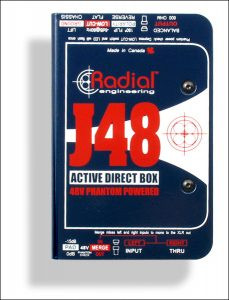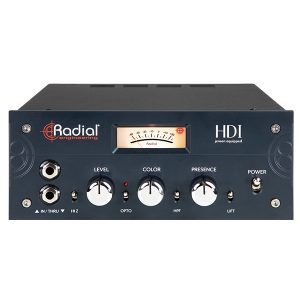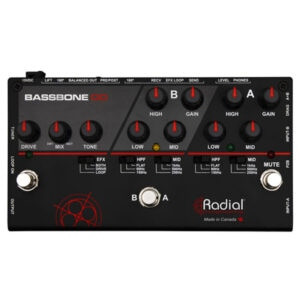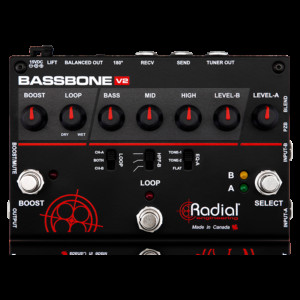When it comes to amplifying your bass guitar, you might be wondering, “What type of direct box works best for bass guitar?”. The answer, as with many things in music gear, isn’t a simple one-size-fits-all. It largely depends on your bass guitar itself, specifically whether it’s a passive or active instrument. Understanding the nuances between these types and how they interact with direct boxes (DIs) is crucial for achieving the best possible sound, whether you’re on stage or in the studio.
To understand why different DIs are better suited for different basses, let’s first delve into the basics of bass guitar signal flow and the historical context that led to the invention and evolution of the direct box.
The Birth of the Direct Box: Taming the Stage Volume
Early electric bass guitars, like the iconic Fender Precision, were passive instruments. These basses rely on magnetic pickups to generate a signal. As the strings vibrate within the pickup’s magnetic field, a weak alternating current is produced. This signal travels through a cable to a bass amplifier, which boosts the voltage to a level strong enough to power a loudspeaker.
For many years, this setup was sufficient. However, as concert venues grew larger and audiences became louder, bass amps struggled to deliver the necessary low-end punch to cut through the mix. The solution was to route the bass guitar signal into the venue’s primary sound reinforcement system, the PA system.
It was in this context that the direct box was born. Initially, these were rudimentary, often homemade devices containing transformers. These passive direct boxes served to tap a portion of the bass signal, splitting it to send one part to the stage amplifier for monitoring and the other, crucial part to the distant PA system, sometimes hundreds of feet away.
 Radial jdi-topview-intro-lrg
Radial jdi-topview-intro-lrg
Radial JDI passive direct box showcasing its robust and straightforward design, ideal for high-quality signal transfer from bass guitars.
The Problem of Signal Loading and the Rise of Active DIs
As concerts expanded into larger arenas and stadiums with extensive cable runs, bass players began noticing a change in their sound when connected to these complex systems. The bass tone lost its characteristic “beefiness” and low-end “thud.” This phenomenon is known as “signal loading”.
Signal loading occurs because the weak signal from a passive bass pickup struggles to drive long cable lengths and the input impedance of multiple devices simultaneously. The signal weakens, particularly at higher frequencies, resulting in a duller, less impactful sound.
To combat signal loading, active direct boxes were developed. These innovative devices incorporate a small amplifier, or buffer, within the DI itself. This buffer strengthens the bass signal, ensuring that the vast majority of the signal is sent to the stage amp while a clean, robust split is directed to the PA. Active DIs effectively restored the desired punch and low-end response, particularly for passive basses in large venues.
Active Basses and the Passive DI Comeback
The evolution didn’t stop there. Bass technology advanced, and active basses emerged, equipped with onboard preamps powered by batteries. These preamps dramatically increased the output level of the bass signal. Instead of the roughly 1-volt output of a passive bass, active basses could deliver a much hotter signal, sometimes as high as 18 volts.
However, this increased output power presented a new challenge. The high-output signal from active basses could overload the input of active direct boxes, leading to unwanted distortion, a muddy sound, and a loss of clarity in the PA system.
The solution to this modern problem was surprisingly retro: the passive direct box. By using a passive DI with a high-output active bass, the signal is attenuated appropriately, preventing overload and preserving the instrument’s natural tone and dynamic range. The passive DI effectively handles the already buffered and boosted signal from the active bass, ensuring a clean and powerful sound to the PA.
Phantom Power and Headroom Considerations
Early active DIs were battery-powered, which presented its own set of issues, most notably the dreaded dead battery during a performance. To address this, manufacturers began utilizing phantom power, a technology initially designed to power condenser microphones, to power active DIs.
However, phantom power was not originally intended as a robust power source for amplifiers. It provides limited current, which can impact the headroom of an active DI. Headroom refers to the amount of signal level a device can handle before distortion occurs. When a high-output bass signal encounters an active DI powered by phantom power with limited headroom, distortion can creep in, especially with dynamic playing.
While phantom power is convenient, it’s essential to be aware of potential headroom limitations, particularly when using active DIs with very high-output active basses.
 Radial j48-topview-intro-lrg
Radial j48-topview-intro-lrg
The Radial J48 active direct box, powered by phantom power, offers a high-performance solution for various bass guitars, emphasizing clean and transparent signal amplification.
Choosing Between Active and Passive DIs: A Practical Guide
So, how do you choose the right direct box for your bass guitar? Here’s a general guideline:
-
For High-Output Active Basses: A passive direct box is often the best choice. The already buffered and boosted signal from your active bass is well-suited for a passive DI. It will handle the hot signal without overloading, preserving your bass’s natural tone and dynamics.
-
For Low-Output Passive Basses: An active direct box is generally recommended. It will provide the necessary buffering and signal boost to drive long cable runs and ensure a strong, clear signal to the PA system without altering the fundamental sound of your passive bass.
It’s also crucial to remember that the quality of components and circuit design significantly impacts the sound of any DI box, whether active or passive. High-quality DIs prioritize minimizing unwanted distortion, including harmonic, phase, and intermodulation distortion, ensuring the purest possible signal transfer.
Some DIs, like the Radial JDI and J48, are designed for pristine, transparent signal reproduction, faithfully capturing the natural sound of your bass. Others, such as the Radial HDI, offer tonal coloration options, allowing you to intentionally add “good” distortion and texture to your bass tone for creative sound design.
 Radial HDI-thumb-300×300.jpg
Radial HDI-thumb-300×300.jpg
The Radial HDI studio DI, designed for high-definition recording, offers tonal coloration and exceptional sonic versatility for bass and other instruments.
Beyond Basic DIs: Exploring Preamp/DI Combos
For bassists seeking even greater control over their tone and signal routing, preamp/DI combination units offer expanded capabilities. These devices go beyond the fundamental function of a DI box by incorporating a preamp section with features like level controls, multiple inputs for switching between instruments, and comprehensive tone-shaping EQ. Many also include effects loops for integrating pedals and footswitches for on-stage control.
Preamp/DIs essentially transform into the central hub of your stage rig, providing not only a direct output to the PA but also comprehensive tonal control and signal management. Models like the Radial Bassbone OD and Bassbone V2 exemplify this category, offering advanced features such as overdrive circuits, clean boosts, and sophisticated EQ sections, all while maintaining a high-quality DI output.
 Bassbone-OD-feature-thumb-300×300.jpg
Bassbone-OD-feature-thumb-300×300.jpg
The Radial Bassbone OD preamp and overdrive DI, providing comprehensive tone shaping and dual-channel functionality for bassists seeking versatile stage and studio solutions.
 bassbone-v2-thumbnail-300×300.png
bassbone-v2-thumbnail-300×300.png
The Radial Bassbone V2 preamp and boost DI, a compact powerhouse offering exceptional tonal control and audio performance for live and recording bassists.
Conclusion: Choosing the Right DI for Your Bass and Sound
Ultimately, selecting the best direct box for your bass guitar involves considering several factors, primarily the type of bass you play (active or passive) and the sound you aim to achieve.
- Passive DIs excel with high-output active basses, providing clean signal transfer and preventing overload.
- Active DIs are ideal for passive basses, offering signal boosting and buffering for optimal performance, especially over long cable runs.
- Preamp/DI combos offer advanced tonal control and routing options for discerning bassists seeking maximum flexibility.
By understanding the nuances of active and passive direct boxes and their interaction with different types of bass guitars, you can make informed decisions to optimize your bass tone for any performance or recording scenario. Consider your specific needs, experiment with different DI types, and listen critically to find the direct box that best complements your bass and your musical style.
